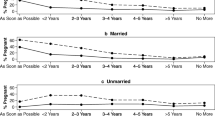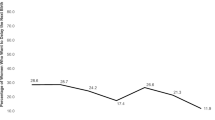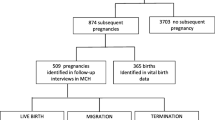Abstract
Over the last 30 years Australian fertility rates have fallen more than could have been predicted from changes in the numbers of children desired by women when they first married. This paper charts changes in desired and completed fertility in Australia, matches originally desired fertility with that ultimately achieved and explores some factors which may affect the relation between fertility desires and fertility outcomes.
Similar content being viewed by others
References
Bracher, M.D. 1987. The Australian Family Project.Journal of the Australian Population Association 4:106–122.
Bracher, M.D. 1990. Explaining first marriage trends in Australia.Journal of the Australian Population Association 7:128–150.
Bracher, M. and G. Santow. 1990. The family histories of Australian women.European Journal of Population 6:227–256.
Bracher, M. and G. Santow. 1991. Accidental pregnancy, side effects and dissatisfaction: premature discontinuation of contraception in Australia. Paper presented at the Population Association of America Annual Meetings, Washington DC, 19–21 March.
Freedman, R., L.C. Coombs and L. Bumpass. 1965. Stability and change in expectations about family size: a longitudinal study.Demography 2:250–275.
Goldberg, D., H. Sharp and R. Freedman. 1959. The stability and reliability of expected family size data.Milbank Memorial Fund Quarterly 37:369–385.
O’Connell, M. and C.C. Rogers. 1983. Assessing cohort birth expectations data from the current population survey.Demography 20:369–384.
Rindfuss, R.R., S.P. Morgan and G. Swicegood. 1988.First Births in America. Changes in the Timing of Parenthood. Berkeley, California: University of California Press.
van de Giessen, H. 1988. Birth expectations as a guide for fertility hypotheses in population projections. Paper presented at the IIASA Conference on ‘Future Changes in Population Age Structure’, Sopron, Hungary, 18–21 October.
Ware, H. 1973. The limits of acceptable family size: evidence from Melbourne, Australia.Journal of Biosocial Science 5:309–328.
Westoff, C.F., E.G. Mishler and E.L. Kelly. 1957. Preferences in size of family and eventual fertility twenty years after.American Journal of Sociology 62(5):491–497.
Westoff, C.F. and N.B. Ryder. 1977a.The Contraceptive Revolution. Princeton, New Jersey: Princeton University Press.
Westoff, C.F. and N.B. Ryder. 1977b. The predictive validity of reproductive intentions.Demography 14:431–453.
Whelpton, P.K., A.A. Campbell and J.E. Patterson. 1966.Fertility and Family Planning in the United States. Princeton, New Jersey: Princeton University Press.
Young, CM. 1974. Numbers of children planned, expected and preferred by women in Melbourne.Journal of Biosocial Science 6:295–304.
Author information
Authors and Affiliations
Rights and permissions
About this article
Cite this article
Bracher, M., Santow, G. Fertility desires and fertility outcomes. Journal of Population Research 8, 33–49 (1991). https://doi.org/10.1007/BF03029554
Issue Date:
DOI: https://doi.org/10.1007/BF03029554




